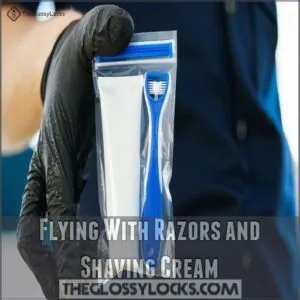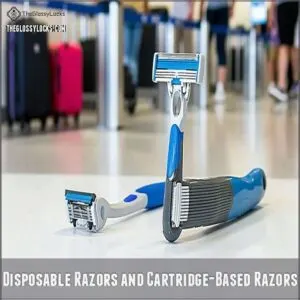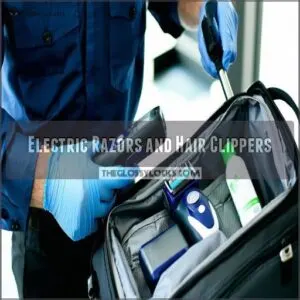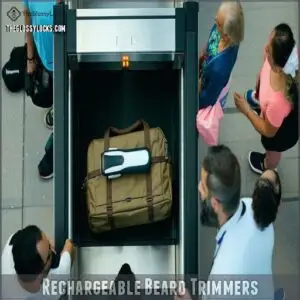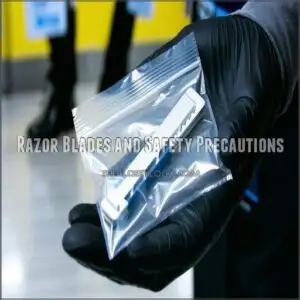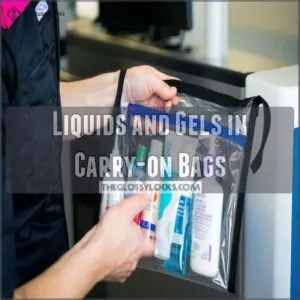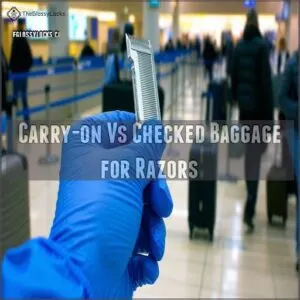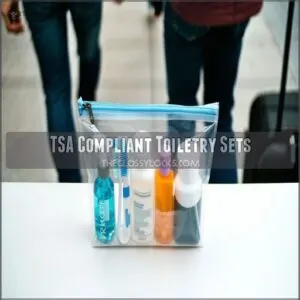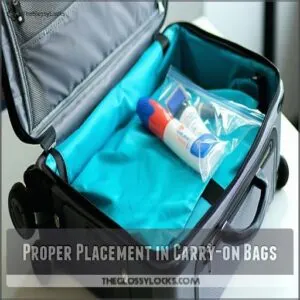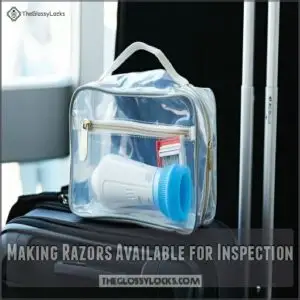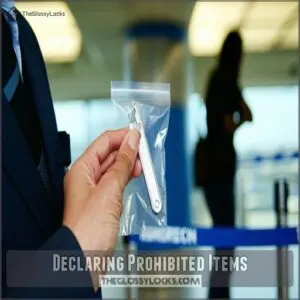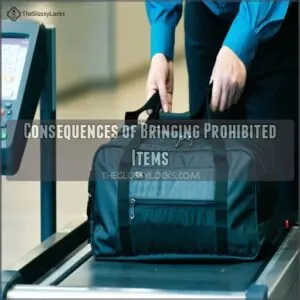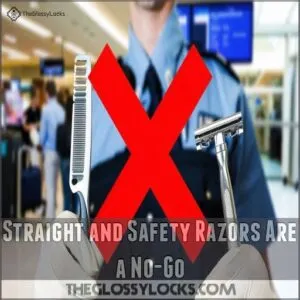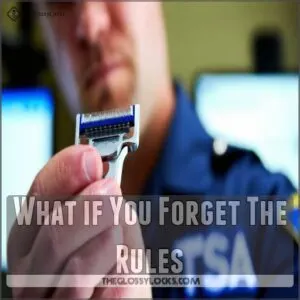This site is supported by our readers. We may earn a commission, at no cost to you, if you purchase through links.
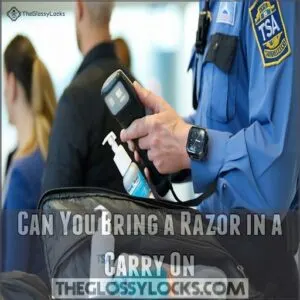 Yes, you can bring certain types of razors in a carry-on.
Yes, you can bring certain types of razors in a carry-on.
Disposable razors and their refills are fine for air travel.
Electric shavers also get a thumbs-up from the TSA.
However, safety razors and straight razors are the villains of the tale—they must be blade-free if you’re packing them in a carry-on, with blades stashed in checked baggage.
So, while your whiskers might be safe from a close shave onboard, your razor collection has to play by the TSA’s rules.
Planning ahead avoids any razors’ edge moments at security—and keeps you smooth-sailing through the checkpoints!
Table Of Contents
- Key Takeaways
- Flying With Razors and Shaving Cream
- Can You Bring a Razor in a Carry On
- Types of Razors Allowed in Carry-Ons
- Liquids and Gels in Carry-on Bags
- Carry-on Vs Checked Baggage for Razors
- TSA Compliant Toiletry Sets
- Packing Razors for Inspection
- Straight and Safety Razors Are a No-Go
- What if You Forget The Rules
- Frequently Asked Questions (FAQs)
- Can you carry a razor on a plane?
- Can you bring a razor in a carry-on bag?
- Are electric razors allowed in carry-on luggage?
- What happens if you put a razor in your carry-on luggage?
- Are disposable razors safe for carry-on bags?
- Can you carry a razor with a battery?
- Can I take a disposable razor in hand luggage?
- Will TSA stop you for a razor?
- Are razors allowed in carry-on or check in?
- Can you take a razor and tweezers in a carry-on?
- Can I bring a beard trimmer in carry-on?
- Are there different rules for international flights?
- What should I do if my razor is confiscated?
- Can I pack a razor in a backpack?
- Are disposable razors safer to bring than safety razors?
- Conclusion
Key Takeaways
- You can bring disposable and electric razors in your carry-on; they’re TSA-approved and won’t cause any issues at security.
- Safety razors and straight razors must be in checked baggage due to their attached blades; packing them in your carry-on isn’t allowed.
- Liquids like shaving cream must follow the 3-1-1 rule: each container should be 3.4 ounces or less and fit in a quart-sized clear bag.
- Always check TSA guidelines for the latest rules to avoid surprises at security and ensure smooth travels.
Flying With Razors and Shaving Cream
Figuring out the best shaving cream for your skin type, such as the Nivea Men Sensitive Shaving Cream, can make all the difference in your shaving experience. Figuring out the TSA rules for flying with razors and shaving cream can feel a bit like solving a puzzle.
Don’t let confusion cloud your trip—understanding the guidelines on razor types and the 3-1-1 rule for liquids will make packing a breeze.
TSA Regulations and Restrictions
Ever wonder what’s allowed in your carry-on regarding razors and shaving cream?
TSA razor rules are clear: disposable and cartridge razors, plus electric ones, are good to go.
But, carrying straight edge or safety razors requires checked baggage.
Remember, shaving cream follows the 3-1-1 liquid rule—keep it 3.4 ounces or less.
Smooth flying!
Razor Types and Allowances
When packing razors for air travel, it’s important to know which types are TSA-approved for carry-ons. You can take:
- Disposable razors and their cartridges
- Electric razors and shavers
- Rechargeable beard trimmers
- Avoid safety razors with blades attached
- Straight razors are a no-go in carry-on bags
Remember, packing carefully helps make your security experience smoother.
Shaving Cream and The 3-1-1 Rule
Shaving cream in your carry-on? That’s a smooth maneuver if you stick to the TSA’s 3-1-1 rule.
This means each container shouldn’t exceed 3.4 ounces, all fitting neatly into a quart-sized zip-top bag.
As far as TSA approved razors go, keep it travel-sized and mindful of liquid limits.
Master these packing tips to breeze through carry-on restrictions.
Packing Razors for Air Travel
So, you’ve got your shaving cream sorted—now, let’s tackle those razors! Packing them right is key to a smooth trip. Here’s what you need to know:
- Disposable razors? Carry-on’s fine.
- Electric razors? Carry-on or checked bag—your call.
- Safety razors? Checked bag only, blade removed.
- Never bring loose blades. That’s a big no-no.
Keep your travel safe and easy!
Can You Bring a Razor in a Carry On
Traveling with razors can seem tricky, but the TSA rules make it clearer.
You can safely pack disposable and electric razors in your carry-on.
But leave those straight and safety razor blades in your checked bag.
Disposable Razors and Refills
Packing for a trip can feel like a game of Tetris with your essentials.
Good news: disposable razors and their refills are TSA-approved for your carry-on.
Make sure to follow these rules:
| Item | Carry-on | Checked | Notes |
|---|---|---|---|
| Disposable Razor | Yes | Yes | Safe for both bags |
| Razor Refills | Yes | Yes | Can pack in carry-on |
| Shaving Cream | Yes* | Yes | Follow 3-1-1 liquid rule |
Don’t fret, you’re good to go!
Electric Razors and Shavers
Thinking of packing your electric razor in a carry-on? It’s definitely doable! Electric razors are a breeze at TSA checkpoints. Just remember these tips:
- Travel-sized shavers: Ideal for carry-on.
- Electric razor types: Consider compact models.
- Charging electric razors: Bring your charger.
- Lithium ion batteries: Safe for air travel.
Stay smooth and ready wherever you roam!
Safety Razors and Straight Razors
Bringing a safety razor on your flight? Here’s the scoop: TSA rules say no blades in your carry-on.
You can pack the razor body, but keep the blades in checked baggage.
Straight razors? They’re a no-go in carry-ons unless securely packed in checked bags.
Fancy a close shave? Make sure your gear follows the TSA regulations. Stay sharp!
TSA Prohibited Razors
Picture yourself breezing through airport security.
Now, imagine trying that with a straight razor tucked in your bag—it’s a guaranteed snag.
TSA regulations firmly place straight razors and loose razor blades on the prohibited list.
Why risk getting held up when carry-on razors like disposables are safe?
Stay smart, avoid TSA confiscations, and guarantee smooth travels every time.
Types of Razors Allowed in Carry-Ons
When packing your carry-on, you’re probably wondering which razors make the cut. Don’t worry—disposable razors, cartridge-based razors, and electric shavers are all good to go!
Disposable Razors and Cartridge-Based Razors
So, you’re ready to pack your carry-on, but what about razors? Disposable razors? Totally fine! TSA rules allow both fully disposable and cartridge-based ones.
Here’s the lowdown:
- Travel-size razors are your best bet.
- To avoid bacteria transfer and keep blades sharp longer through regular disinfecting razors. Keep blades in the razor; no loose blades allowed.
- Check TSA’s website for the most up-to-date info on carry-on limits for your peace of mind.
Safe travels!
Electric Razors and Hair Clippers
Imagine zipping through airport security with your electric razor and hair clippers packed neatly in your carry-on.
These TSA-friendly gadgets are great for a quick grooming session on the go.
Just make sure your devices use lithium batteries that meet airport rules.
Don’t forget a travel charger to keep them juiced up.
Smooth flights and tidy looks, guaranteed!
Rechargeable Beard Trimmers
Have a rechargeable beard trimmer in your carry-on? No problem! These handy gadgets are TSA-approved. Here’s a quick list to make sure you’re travel-ready:
- Battery Life: Fully charge to avoid hassle mid-trip.
- Travel Charging: Pack the charger in case you need power on the go.
- Trimmer Choice: Opt for the best travel trimmers for easy handling.
Razor Blades and Safety Precautions
Packing razor blades in your carry-on? It’s a no-go. TSA rules are clear as day: keep sharp objects, like safety razor blades, out of your carryon to avoid safety concerns.
To make sure you have a stress-free journey, following TSA rules on carry-on luggage restrictions is key.
Got your mind set on safety razors? Check ’em in, where they belong.
Trusty Table Time:
| Item | Carry-On | Checked Bag |
|---|---|---|
| Disposable | Yes | Yes |
| Cartridge | Yes | Yes |
| Electric | Yes | Yes |
| Rechargeable | Yes | Yes |
| Safety Razors | No | Yes |
Liquids and Gels in Carry-on Bags
When you’re packing your carry-on, remember that liquids and gels must follow the TSA’s 3-1-1 rule, meaning containers should be 3.4 ounces or less.
You’ll want to neatly tuck them all into a single quart-sized zip-top bag to breeze through security without a hitch.
Containers and Quantity Limitations
When you’re considering razors and toiletries for your carry-on, remember the TSA’s 3-1-1 liquids rule.
Each liquid item, like shaving cream or gel, must be in containers of 3.4 ounces or less.
This makes sure a smooth trip through security.
Too big, and it ends up in your checked baggage.
Understanding these size limits helps you avoid security hassles, making air travel as smooth as possible.
Placing Containers in Zip Lock Bags
Imagine this: you’re zipping through security with your liquids neatly packed in TSA-approved bags.
It’s the art of the "311 liquids rule," and it’s your ticket to a hassle-free experience.
Don’t forget that shaving soap in carry-on rules may require solid shaving soap to be separated from liquids and gels.
Each travel-size container, snug in its zip lock bag, keeps your carry-on liquids under control.
Just remember, one quart-sized bag per traveler ensures your shaving cream, shampoo, and other essentials stay compliant with TSA allowed items.
Easy peasy, right?
No Size Limitations for Liquids in Checked Bags
Checked baggage offers a liberating escape from the tyranny of the 3-1-1 rule.
That’s right, forget those tiny travel bottles! Your larger shampoo, conditioner, and even that jumbo-sized shaving cream can happily reside in your checked luggage.
No more stressful squeezing and measuring thanks to being aware of TSA guidelines for travel shaving kit essentials; pack those travel essentials with carefree abandon.
Remember, though, checked bag size limits still apply – check your airline’s guidelines for specifics.
This is a great travel tip for those who want more freedom and control while packing liquids.
Enjoy that extra space and peace of mind!
Carry-on Vs Checked Baggage for Razors
When packing razors for your flight, understand what fits in your carry-on and what’s safer in checked baggage.
Knowing TSA rules can spare you any awkward airport moments—nobody wants their razor mistaken for a threat!
Safety Razors and Straight Razors in Checked Baggage
While you pack your carry-on, consider where those pesky shaving rules apply.
Safety razors need a safe spot in your checked baggage due to TSA regulations.
Straight razors? Same deal—get them packed down below.
These sharp tools aren’t allowed on board, and for good reason; learn more about TSA Regulations for Razors.
So, stash them with care, sidestep airport headaches, and breeze through security with ease.
Larger Containers of Shaving Cream in Checked Baggage
When packing for a flight, remember that your giant shaving cream cans need to ride in checked baggage, not your carry-on.
TSA rules cap carry-on liquids at 3.4 ounces, so larger containers go in checked bags.
This makes sure you’re set for a smooth journey without hassle at security.
Consider travel-sized options for convenience and compliance with TSA guidelines.
Prohibited Items in Carry-on and Checked Baggage
Flying with razors? Slap on your thinking cap! TSA’s got rules—sharp items like knives and straight razors are a big no-no in your carry-on. Slip your safety blades into checked bags instead.
Liquids and gels, like your favorite shampoo, must adhere to the 3-1-1 rule.
Bring chocolate or a nice book while waiting, but avoid prohibited medications and tools.
Exceptions and Special Cases
Understanding the rules isn’t like threading a needle.
Medical razors and sporting blades get special passes, but always check with TSA.
If your razor isn’t allowed in carry-on, consider packing it in a checked razor case.
Military personnel might carry unique tools, yet TSA’s discretion remains key.
For those with disability needs, exemptions exist.
Grab your carryon razors—disposable and electric are mostly fine.
Just be sure to pack batteries separately to avoid hiccups.
TSA Compliant Toiletry Sets
When you’re packing for a flight, choosing a TSA-compliant toiletry set can save you from headaches at the security checkpoint.
TSA-compliant toiletry set and 3-1-1 rule can help you avoid hassles at the security checkpoint.
Make sure your toiletries, including razors and liquids, fit snugly in a clear quart-sized bag and meet the 3-1-1 rule for a hassle-free travel experience.
Choosing The Right Toiletry Bag
Choosing the right toiletry bag is key for stress-free travel.
Consider size—it needs to fit your carry-on.
Durable material prevents leaks; look for water-resistant options.
Features like multiple compartments improve organization.
Think about durability; you want a bag that can handle rough travel.
Remember TSA carry-on restrictions on liquids; a see-through bag simplifies security checks.
A well-chosen bag makes packing your allowed razor and carry-on toiletries a breeze.
Packing Toiletries for Air Travel
You’ve got the right toiletry bag, but packing it right makes for a smooth airport experience.
Stick to travel-size toiletries and follow TSA’s liquids rule: 3.4-ounce containers in a quart-sized ziplock bag.
Keep essentials like your travel razors handy.
This way, you’ll breeze through security with confidence, keeping your freedom intact and avoiding those pesky delays.
TSA Regulations on Toiletries
Packing your toiletries involves keeping TSA rules top of mind, especially the liquids limit.
Make sure each liquid or gel is 3.4 ounces or less, neatly tucked into a quart-sized bag.
Razors, specifically disposable and cartridge types, are carry-on friendly.
Remember, regarding carry-on restrictions, packing tips like these can help avoid surprises with prohibited items.
Tips for a Smooth Security Check
Going through airport security? It should be a breeze if you’ve got a solid plan for your toiletries and razors. Check the specific rules for rechargeable beard trimmers to make sure you comply with TSA regulations.
Here are key tips:
- Pack Smart: Place all liquids in a clear quart-sized bag.
- Know What’s Allowed: Disposable razors are fine, but straight razors aren’t.
- Stay Organized: Keep toiletries accessible for quick inspection.
Stay calm, and travel smoothly!
Packing Razors for Inspection
When packing razors in your carry-on, place them in an easily accessible area for quick inspection. Pay attention to TSA guidelines to avoid any hold-ups at security.
Proper Placement in Carry-on Bags
TSA guidelines can feel like a puzzle, but packing razors is straightforward.
Keep disposable razors in your carry-on essentials with toiletries for easy access.
Think of a bag as your razors’ safe haven—avoid prohibited items.
Follow the liquids rule by securing shaving gels in a zip lock.
These packing tips help you avoid hassles at security.
Making Razors Available for Inspection
You’ve got your carry-on neatly packed, but don’t forget about making your razors easily accessible for TSA inspection. Here’s how you can make that process smooth:
- Pack razors in a clear toiletry bag for visibility.
- Keep the bag at the top of your carry-on for quick access.
- Stay organized to speed through airport security with ease.
Declaring Prohibited Items
Got your razors neatly arranged? Great!
Honesty is the best policy.
If you accidentally packed something from the prohibited items list, don’t panic.
Declare it to a TSA agent.
This helps avoid problems at airport security and keeps things moving smoothly.
Think of it as a simple heads-up, not a confession.
It’s all about clear communication.
Consequences of Bringing Prohibited Items
Bringing prohibited items like razor blades leads to a sticky situation at airport security. Why risk it? Here’s what you face:
- Confiscated Items: Your precious carry-on razors get tossed. Check the TSA razor rules beforehand to avoid such issues, and consider purchasing TSA-approved products from stores offering Travel Razor Kits.
- Security Questioning: Expect a chat with security that might include TSA fines.
- Flight Delays: This can cause travel disruptions, leaving your holiday plans shaved down before they start.
Straight and Safety Razors Are a No-Go
When you’re packing for a flight, leave your straight razors and safety razors in checked baggage.
These sharp items aren’t allowed in your carry-on, so don’t risk holding up the security line with these blades.
Straight Edge Razors and Safety Razors
Setting out for your trip, it’s important to remember that straight edge razors and safety razors aren’t welcome in carry-ons.
According to TSA regulations, these sharp tools must go in checked baggage to keep everyone’s safety in check.
Think of it as a small hurdle for a smoother journey. Pack wisely and keep your shaving routine hassle-free by adhering to these carry-on restrictions.
Double-Edge Razors and Daggers
Why risk it? Double-edge razors and daggers are a no-go for carry-on luggage.
TSA rules prioritize safety, meaning these sharp items should definitely go in your checked baggage.
Picture your favorite travel grooming tool—now imagine it confiscated at security.
Save the hassle and guarantee blade safety by keeping risky razors away from carry-ons.
Stay smart, stay smooth.
Prohibited Razors in Carry-on and Checked Baggage
Packing for a flight? Watch out for razor blade regulations. Some items definitely can’t fly in carry-on bags:
- Straight Razors: These aren’t allowed in carry-on or checked baggage.
- Safety Razors with Blades: Carry-on razor restrictions apply here, so pack blades in checked bags only.
- Box Cutters and Utility Knives: Firmly prohibited.
- Loose Blades: Avoid packing these in carry-on baggage entirely.
Alternatives to Prohibited Razors
Since straight and safety razors aren’t allowed in your carry-on, look to disposable razors or travel-sized electric shavers.
These handy alternatives let you glide through security without a hitch.
Consider trimming tools like rechargeable beard trimmers, which are hassle-free for your journey.
Remember, a clever packing twist can transform your travel experience, ensuring you’re both groomed and grounded.
What if You Forget The Rules
Don’t worry if you’re a little fuzzy on the rules; TSA agents have the final say, so it’s best to double-check before you head to the airport to avoid any surprises.
Knowing the rules beforehand will save you time and potential frustration at security.
TSA Agents’ Final Say
Airport security can sometimes feel like a game of chance, but remember, TSA agents’ discretion is the final word.
If you’ve packed a razor in your carry-on, here’s what might happen:
- It’s allowed: You breeze through.
- It’s questionable: Expect extra inspection.
- It’s banned: It might be confiscated.
- You must dispose of it: Say goodbye.
To make sure you’re following the rules, you can also check out products compliant with TSA Razor Rules.
Travel tips: Check your toiletries!
Tips for Avoiding Issues at Security Check
If TSA agents have the final say, it’s smart to stay ahead of the game.
Double-check your items, focusing on TSA guidelines to dodge any hiccups.
Make sure to follow the liquids rule—keep those mini bottles snug in a clear bag.
With razors, remember what’s allowed: disposable and electric are fine, but steer clear of prohibited items.
Pack with a plan, ensuring a smooth security check journey.
Preparing for Air Travel With
Air travel prep is like a game. You know the rules but sometimes slip up. Forget the TSA guidelines? Don’t sweat it.
Before heading to the airport, double-check your carry-on essentials. Make sure your travel razor and toiletries fit the carry-on liquids restrictions. Keep prohibited items out.
Quick-pack everything in travel-friendly sizes, and know the allowed razor carry-on details. Stay sharp and fly through security!
Frequently Asked Questions (FAQs)
Can you carry a razor on a plane?
You can bring a disposable or electric razor in your carry-on without worries.
Just don’t pack safety or straight-edge razors with blades attached; those belong in checked bags.
Feel free to keep your shave on point!
Can you bring a razor in a carry-on bag?
Most razors are okay in carry-ons, but not blades alone. Disposable and electric razors are generally allowed. Check TSA guidelines for specifics; better safe than sorry!
Are electric razors allowed in carry-on luggage?
Electric razors are totally fine in your carry-on bag.
They offer a hassle-free grooming option without worrying about TSA rules.
You can pack them alongside your other travel essentials and buzz off without a hitch.
Safe travels!
What happens if you put a razor in your carry-on luggage?
TSA won’t stop you for carrying disposable or electric razors in your carry-on.
Checked luggage is required for safety and straight razors.
Improper packing could lead to a quick confiscation at security.
Are disposable razors safe for carry-on bags?
Wondering if you can bring disposable razors on a plane?
Don’t worry, you’re in the clear!
Disposable and cartridge-based razors are allowed in your carry-on.
Keep them handy for those on-the-go grooming needs.
Safe travels!
Can you carry a razor with a battery?
Yes, you can take a battery-powered razor in your carry-on.
They’re allowed by TSA, so you won’t face any hiccups.
Just make sure it’s packed securely to avoid activation during your journey, and you’ll be set!
Can I take a disposable razor in hand luggage?
You can definitely bring a disposable razor in your hand luggage.
Those little grooming essentials are travel-friendly and won’t cause any hiccups at security checkpoints.
Just pack them neatly, and you’ll breeze through with no issues.
Will TSA stop you for a razor?
Traveling can feel like walking a tightrope regarding TSA rules.
Don’t worry, TSA won’t stop you for a disposable razor in your carry-on, but keep straight razors in checked luggage to avoid issues.
Are razors allowed in carry-on or check in?
Packing a razor? Disposable ones are fine in carry-ons.
Electric razors? Those are good to go in either your carry-on or checked bag.
But leave the straight razors and blades at home; those are a no-go.
Can you take a razor and tweezers in a carry-on?
Yes, you can take disposable razors and tweezers in your carry-on.
Disposable razors are allowed, but keep safety razors without their blades.
Let tweezers join the fray, as they’re perfectly safe for air travel.
Can I bring a beard trimmer in carry-on?
You can bring a beard trimmer in your carry-on without any issues.
TSA allows electric razors in carry-on luggage, so you’re good to go.
Just make sure it’s packed neatly to avoid any confusion.
Are there different rules for international flights?
International flights can have different rules for bringing razors in carry-ons.
Always check both the departure and destination countries’ regulations.
While many rules are similar, variations exist, ensuring you stay informed prevents any mid-travel surprises.
What should I do if my razor is confiscated?
Think of airport security as the guardian of the skies, ensuring a safe journey.
If your razor is confiscated, calmly ask why, learn the rules, and maybe chuckle at escaping that awkward shaving fiasco mid-flight.
Can I pack a razor in a backpack?
Packing a razor in your backpack is generally fine, but stick to disposable razors or those with cartridges for carry-ons.
Blades like safety razors must be checked.
Always check the latest TSA guidelines before flying.
Are disposable razors safer to bring than safety razors?
You’re better off bringing disposable razors in your carry-on, as they’re TSA-approved.
Safety razors require checking the blade separately, making them trickier to pack.
Going disposable simplifies travel, keeping your mind at ease through security checks.
Conclusion
Remember Sarah? She almost missed her flight because she forgot the TSA rules about bringing a razor in a carry-on.
So, before you pack, check the guidelines!
Can you bring a razor in a carry-on? Generally, yes, but it depends on the type.
Disposable and electric razors are usually fine.
However, safety and straight razors require extra care, potentially needing to be packed in checked baggage.
Knowing the rules beforehand saves you time and stress at security.
Happy travels!

